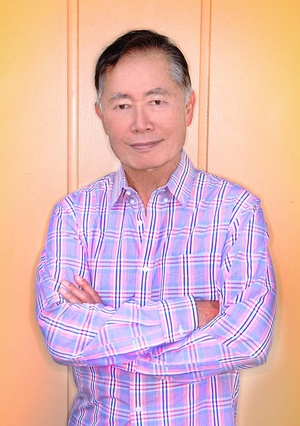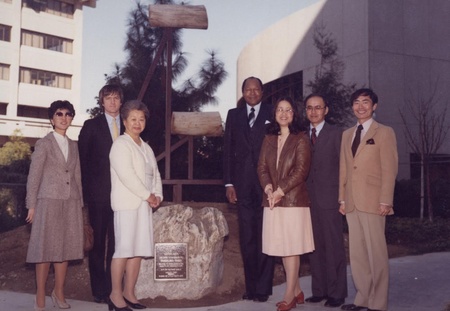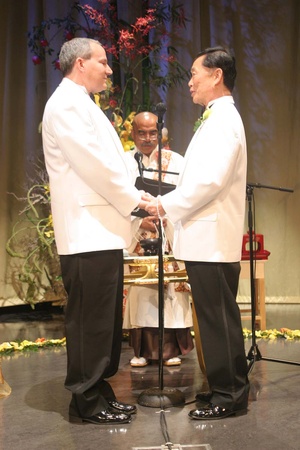George Hosato Takei was born in Los Angeles in 1937 to an Issei father, Takekuma Norman Takei, and Nisei mother, Fumiko Emily Nakamura. He was only five years old when his family was rounded up along with 120,000 other Japanese Americans and sent to concentration camps by the U.S. government following the Japanese bombing of Pearl Harbor. Much of Takei’s childhood was spent at the camps in Rohwer, Arkansas, and Tule Lake, California.
After resettling with his family in Los Angeles after the war, Takei discovered an interest in acting. He earned both bachelor’s and master’s degrees in theater at the University of California, Los Angeles and embarked on a career in theater, television, and film. His big break came in 1966 when he won a starring role as Lieutenant Hikaru Sulu on the groundbreaking TV series Star Trek. Sulu remains to this day one of the iconic roles for Asian American actors, recognized by audiences worldwide.
Takei went on to make countless guest appearances on popular TV shows, from My Three Sons, The Six Million Dollar Man, and Hawaii Five-O (both versions) to Will and Grace, The Simpsons, and Heroes, the latter of which featured him in a recurring role. He has acted in over 40 feature films, including Ice Palace (1960), The Green Berets (1968), Return from the River Kwai (1989), and six Star Trek movies. Takei has also done extensive voiceover work, and been a frequent guest on The Howard Stern Show since 1990. He is now preparing to star in Allegiance, a musical play inspired by his own childhood experiences in the World War II incarceration camps. After a successful run at San Diego’s Old Globe Theater, Allegiance will open on Broadway later this year. Allegiance marks the first time that the mass incarceration of Japanese Americans has been dealt with on the Broadway stage, and Takei proudly considers it his “legacy project.”
In addition to his acting career, Takei has been highly active in public service. In 1973, he ran for Los Angeles City Council and lost by fewer than 2,000 votes. Takei was then appointed by Mayor Tom Bradley to the board of the Southern California Rapid Transit District, where he served from 1973 to 1984. In 1978, he was the tiebreaker in the vote that would create the Los Angeles subway system; he was also a driving force behind the award-winning Metro Art program, which commissions a unique artwork for every station in the Metro rail system. During the Clinton presidency, Takei was appointed by the president to the board of the Japan-United States Friendship Commission, where he served two terms.
Another major milestone in Takei’s life was reached in 2005, as he revealed through a Frontiers magazine interview that he is gay and had been in a committed relationship with his partner, Brad Altman (now Brad Takei), for many years. Takei’s sexual orientation had been something of an open secret in Hollywood; his decision to formally come out was prompted by Governor Arnold Schwarzenegger’s veto of same-sex marriage legislation.
Since coming out, Takei has become an effective advocate for LGBT rights, speaking widely about his own experiences, holding public figures accountable for homophobic comments, and serving as a spokesperson for the Human Rights Campaign. In 2008, the Takeis became the first same-sex couple to apply for a marriage license in West Hollywood. They were married later the same year in JANM’s Tateuchi Democracy Forum, in a ceremony presided over by Reverend William Briones of the Nishi Hongwanji Buddhist Temple.
Takei has enjoyed a renewed wave of popularity in recent years thanks to the infectious humor and warmth of his Facebook page, which has over eight million followers. He catalogued and reflected upon his social media success in two bestselling books: Oh Myyy!: There Goes The Internet and Lions and Tigers and Bears: The Internet Strikes Back, both published in 2013. Takei’s autobiography, To the Stars, was published in 1994 and is still in print. In addition, a documentary film about his life and career called To Be Takei, directed by Jennifer M. Kroot, was released in 2014 to critical and popular acclaim.
Takei has an asteroid named after him (Asteroid 7307 Takei) and has been honored with myriad awards, including Japan’s Order of the Rising Sun, Gold Rays with Rosette, in recognition of his contributions to U.S.-Japanese relations, and the Gay and Lesbian Alliance Against Defamation (GLAAD) Vito Russo Award, for his efforts to promote LGBT equality. At the youthful age of 78, George Takei is as vital and relevant as ever.
George Takei and JANM
George Takei’s public service efforts have reached far and wide, embracing a variety of communities. His relationship with the Japanese American National Museum, however, is a special and enduring one that dates back to JANM’s inception.
When founding president Bruce T. Kaji was in the process of gathering a coalition of allies to support the building of the museum in the mid-1980s, one of the first meetings he took was with Takei. As Takei recalls: “There had been many small exhibits, primarily aimed at the [Japanese American] community. But here was the idea of building a national museum—because our story is an important part of American history—to tell our story, as Americans, to all of America, and to let them know that it was our U.S. Constitution that was egregiously violated. This was very important. And so I signed on right away and joined the board.”
Takei has been an active and generous member of the JANM Board of Trustees ever since. He served as Chair of the Board of Trustees from 2000 to 2004, the first chair to preside over the museum following the opening of the Pavilion Building. It was an eventful tenure in many ways, as it also encompassed the 9/11 attacks, an incident that for many Japanese Americans immediately recalled the bombing of Pearl Harbor. The board and staff of JANM, along with other Japanese American organizations, immediately sought ways to help prevent public hysteria from taking hold. Among other efforts, the JANM board held a meeting in Dearborn, Michigan, to provide counsel to members of the Arab American community there, eventually assisting them in the founding of the Arab American National Museum in 2005. In 2004, JANM became the only California venue to host the Smithsonian Institution’s traveling exhibition, September 11: Bearing Witness to History.
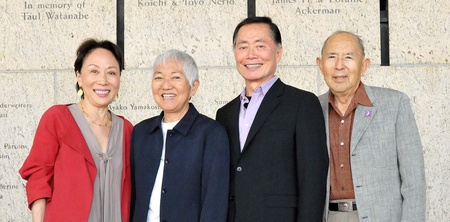
Takei has been a speaker at many important events, including JANM’s 2004 National Conference in Arkansas, “Camp Connections: A Conversation About Civil Rights and Social Justice in Arkansas,” where he filled in for Bill Clinton, who had to cancel at the last minute due to a medical emergency, and the 2008 National Conference in Seattle, “Whose America? Who’s American? Diversity, Civil Liberties, and Social Justice.” Because of his passion for volunteerism, Takei made a generous gift to create the George Takei Volunteer Center, a dedicated work space for JANM’s corps of volunteers. At every opportunity, he vigorously promotes the museum, its mission, and its programs. Whenever he has appeared on competition or game shows, such as Celebrity Apprentice and The Newlyweds, he has always explicitly designated JANM as the recipient of all of his winnings. And of course, he chose JANM’s Tateuchi Democracy Forum as the site for his wedding to Brad—one of the major events of his life.
Takei continues to regard JANM as a top priority in his life. In his own words: “The museum is very important to me because first of all, it’s personal: it’s my story, it’s my family’s story, and it’s the story of my community’s experience. Beyond that, it’s an important part of American history that still, to this day, too few people know about. [Many people are] absolutely astounded that the World War II incarcerations happened here in the United States. And that’s why this institution is so important. It tells that story for all Americans, and it strives to ensure that it never happens again.”
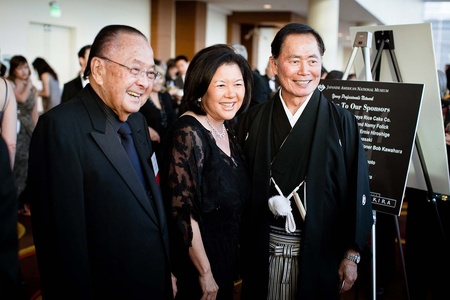
Distinguished Medal of Honor
The Distinguished Medal of Honor for Lifetime Achievement and Public Service is the highest honor given by the museum and Takei is only the fifth recipient, joining former Secretary of Transportation Norman Y. Mineta (2012), the late Sony Corporation co-founder Akio Morita (1996), the late Senator Daniel Inouye (1994), and the late Senator Masayuki “Spark” Matsunaga (posthumously, 1991). JANM’s Medal of Honor was established in 1991 to recognize the lifetime achievements of outstanding persons who have distinguished themselves in their professional and civic work, made significant impact on a national and international scale, and placed the museum among their highest priorities.
*This article was originally published in the Japanese American National Museum’s 2015 Gala Dinner Journal, To Boldly Go: Sharing Our Story Across the Generations.
© 2015 Japanese American National Museum


